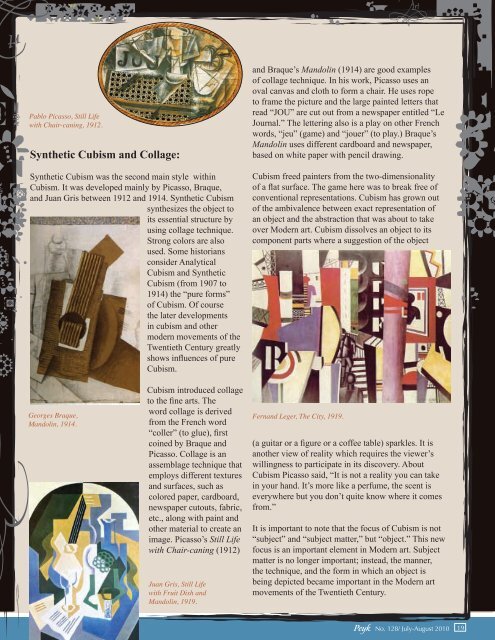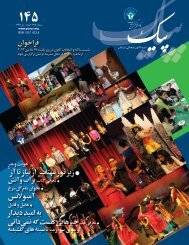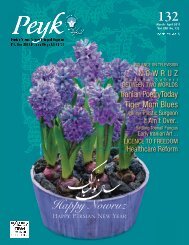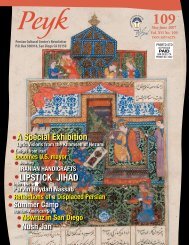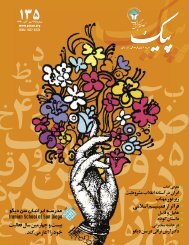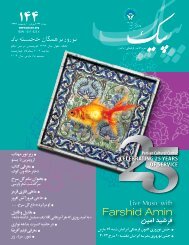English Section - Persian Cultural Center
English Section - Persian Cultural Center
English Section - Persian Cultural Center
Create successful ePaper yourself
Turn your PDF publications into a flip-book with our unique Google optimized e-Paper software.
Pablo Picasso, Still Life<br />
with Chair-caning, 1912.<br />
Synthetic Cubism and Collage:<br />
Synthetic Cubism was the second main style within<br />
Cubism. It was developed mainly by Picasso, Braque,<br />
and Juan Gris between 1912 and 1914. Synthetic Cubism<br />
synthesizes the object to<br />
its essential structure by<br />
using collage technique.<br />
Strong colors are also<br />
used. Some historians<br />
consider Analytical<br />
Cubism and Synthetic<br />
Cubism (from 1907 to<br />
1914) the “pure forms”<br />
of Cubism. Of course<br />
the later developments<br />
in cubism and other<br />
modern movements of the<br />
Twentieth Century greatly<br />
shows influences of pure<br />
Cubism.<br />
Cubism introduced collage<br />
to the fine arts. The<br />
word collage is derived<br />
from the French word<br />
“coller” (to glue), first<br />
coined by Braque and<br />
Picasso. Collage is an<br />
assemblage technique that<br />
employs different textures<br />
and surfaces, such as<br />
colored paper, cardboard,<br />
newspaper cutouts, fabric,<br />
etc., along with paint and<br />
other material to create an<br />
image. Picasso’s Still Life<br />
with Chair-caning (1912)<br />
Juan Gris, Still Life<br />
with Fruit Dish and<br />
Mandolin, 1919.<br />
and Braque’s Mandolin (1914) are good examples<br />
of collage technique. In his work, Picasso uses an<br />
oval canvas and cloth to form a chair. He uses rope<br />
to frame the picture and the large painted letters that<br />
read “JOU” are cut out from a newspaper entitled “Le<br />
Journal.” The lettering also is a play on other French<br />
words, “jeu” (game) and “jouer” (to play.) Braque’s<br />
Mandolin uses different cardboard and newspaper,<br />
based on white paper with pencil drawing.<br />
Cubism freed painters from the two-dimensionality<br />
of a flat surface. The game here was to break free of<br />
conventional representations. Cubism has grown out<br />
of the ambivalence between exact representation of<br />
an object and the abstraction that was about to take<br />
over Modern art. Cubism dissolves an object to its<br />
component parts where a suggestion of the object<br />
(a guitar or a figure or a coffee table) sparkles. It is<br />
another view of reality which requires the viewer’s<br />
willingness to participate in its discovery. About<br />
Cubism Picasso said, “It is not a reality you can take<br />
in your hand. It’s more like a perfume, the scent is<br />
everywhere but you don’t quite know where it comes<br />
from.”<br />
It is important to note that the focus of Cubism is not<br />
“subject” and “subject matter,” but “object.” This new<br />
focus is an important element in Modern art. Subject<br />
matter is no longer important; instead, the manner,<br />
the technique, and the form in which an object is<br />
being depicted became important in the Modern art<br />
movements of the Twentieth Century.<br />
No. 128/ July-August 2010 19


